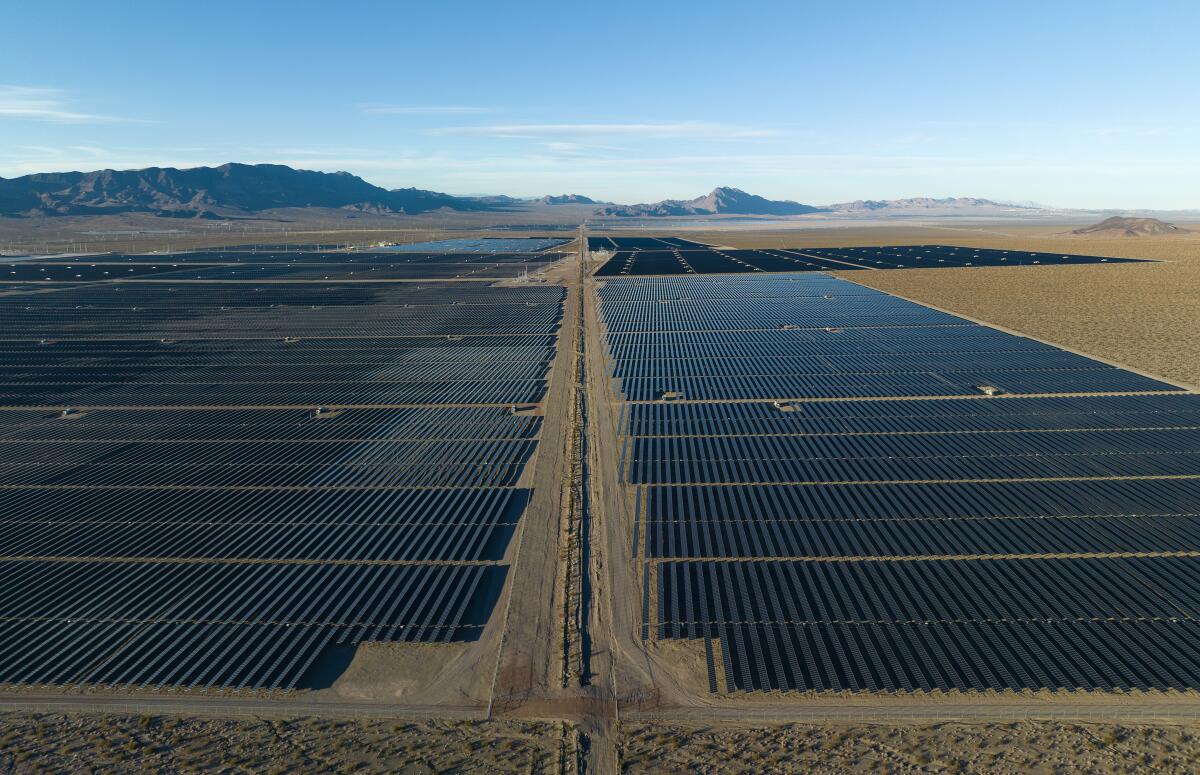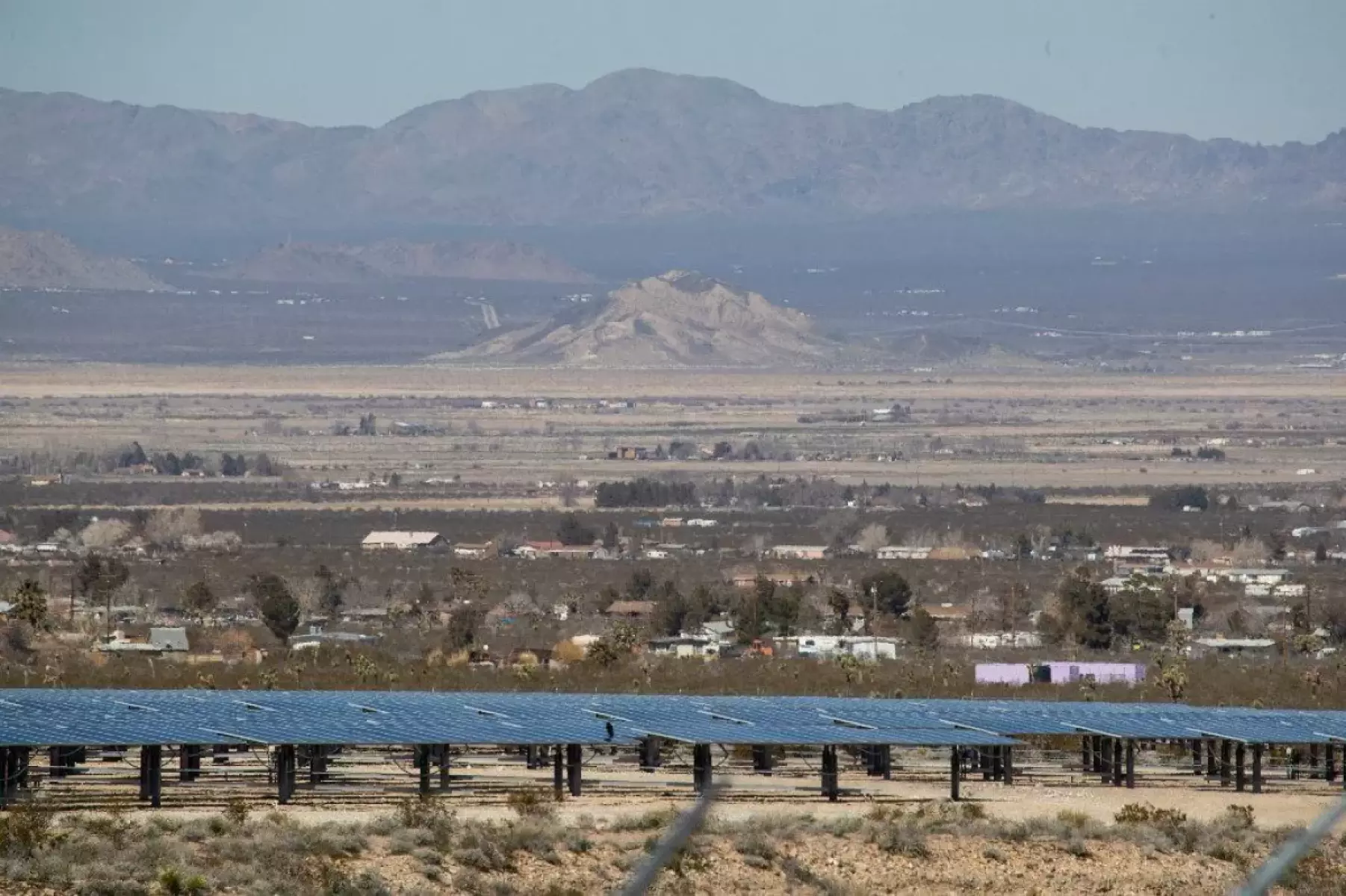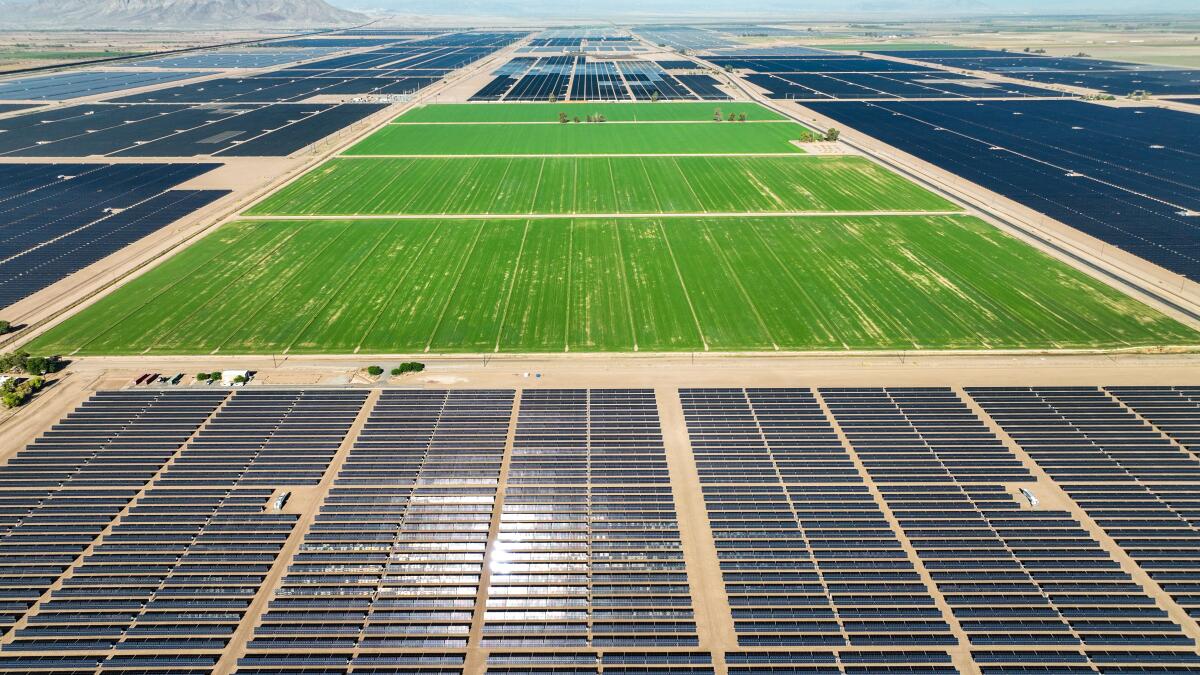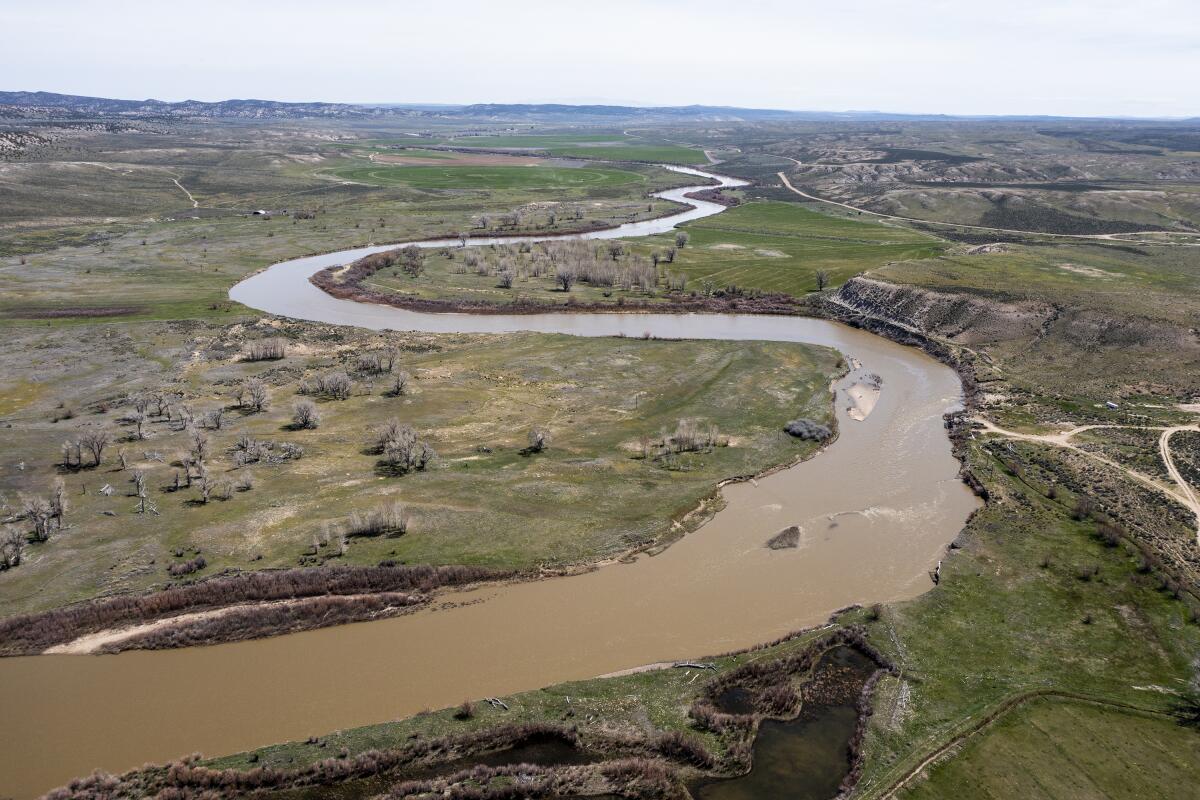Column: Solar companies and environmentalists say they’re ready to stop fighting. They’d better be

The United States has more than enough sunlight and wind to keep electricity flowing to our homes and businesses and factories most hours of most days — if only we could stop fighting over where to put all the solar panels and wind turbines.
A new agreement could be the first step toward bringing some of that fighting to an end.
After nearly two years of negotiations, a coalition of solar companies, conservationists and other groups has come to terms on a set of principles — and plans for further collaboration — that could speed up the construction of badly needed renewable energy projects while also protecting wildlife habitat, preserving treasured landscapes and benefiting nearby communities.
You're reading Boiling Point
Sammy Roth gets you up to speed on climate change, energy and the environment. Sign up to get it in your inbox twice a week.
You may occasionally receive promotional content from the Los Angeles Times.
The dozen solar developers and environmental groups that signed the deal committed to the “Three C’s”: climate, conservation and community. They said they would work together to improve large-scale solar development by limiting damage to ecosystems and prime farmland, and by spreading the wealth to nearby people and towns — all while keeping the climate crisis top of mind.
That’s easy to say and hard to do. But the first-of-its-kind agreement, unveiled late Wednesday, serves as a reminder that compromises are needed to end the combustion of fossil fuels — and that we’re capable of making those compromises.
“It took a lot of work to get these solar developers to a point of comfort, where they would in fact commit to working through these problems and putting real solutions into place,” said Dan Reicher, the Stanford University researcher and former Clinton administration official who launched and led the “Uncommon Dialogue” that produced the agreement. “No guarantees, but I think this is closer to a nationwide resolution of this very difficult obstacle to large-scale solar than anything I’ve seen.”
I’ve spent nearly a decade writing about battles between renewable-energy companies and their critics — especially in one of America’s solar hot spots, the Mojave Desert. The disputes can be fierce, the quandaries gut-wrenching: Is it worth paving over desert tortoise habitat or uprooting Joshua trees to build a solar farm that could help save those species from rising temperatures? What about a power line that will carry wind energy to California but disrupt dwindling sage grouse habitat?
The more solar we put on urban rooftops, the less we’ll need in the desert. The less electricity we use overall, the better.
But even with those types of solutions, scientists have consistently found that keeping global warming to less-than-catastrophic levels — and avoiding even deadlier heat waves, more severe droughts and stronger storms than those we’re suffering today — will require a rapid, unprecedented build-out of sprawling solar farms, massive wind turbines and long-distance electric lines.
That’s unwelcome news to local conservation groups whose members have dedicated themselves to protecting the sagebrush ecosystems, grasslands and ephemeral streams that they know and love. It’s also an affront to small-town residents who don’t want to see their favorite views obliterated, or their backyard dirt-biking trails torn up to generate electricity for faraway cities.
All of which brings us back to the deal produced by Stanford’s “Uncommon Dialogue.”
The signatories include some of the nation’s largest solar energy developers, among them EDF Renewables, Intersect Power and Invenergy. They’ve essentially acknowledged that they need to work harder to build solar farms in the least-damaging spots, and to engage with skeptical residents of nearby towns instead of trying to steamroll opposition. That’s a big deal.

The environmental groups that signed on — including the National Audubon Society, the Natural Resources Defense Council and the Theodore Roosevelt Conservation Partnership — offered their own acknowledgment: that we won’t avert the worst effects of the climate crisis unless we’re willing to accept some level of environmental damage from renewable energy facilities.
“There’s never going to be 100% agreement on 100% of projects,” said Jessica Wilkinson, a top official at the Nature Conservancy, which helped lead the negotiations. “But we want to make those projects that advance climate goals, minimize impacts to nature and maximize benefits to communities become more the norm. Let’s make it faster, easier and cheaper for those projects.”
That’s absolutely the right idea. The key question is whether we can do it fast enough.
It took 20 months for the “Uncommon Dialogue” participants to agree on high-level principles. Now they’ll begin working with one another — and most likely dozens of other companies and nonprofits — to craft specific energy development guidelines and policy recommendations through six working groups. The agreement envisions their work continuing for at least two years.
That’s a lot of time, at a moment in human history when time is painfully short. Scientists have found that keeping global temperature increases to 1.5 degrees Celsius of warming — the goal endorsed by nearly every nation at the 2015 Paris climate summit — would require cutting carbon pollution nearly in half by 2030. Instead, emissions have continued to rise.
The dangers of moving too slowly to burn less coal, oil and natural gas have become painfully clear. Earth just followed up its hottest July on record and hottest August on record with its hottest September on record — by a margin that one climate scientist called “absolutely gobsmackingly bananas.” The American West’s most important water sources are less reliable than ever.
Can we really wait for a bunch of solar companies and big environmental groups to hash out their differences? And even if they do, what about all the rural residents and local conservationists who will continue to fight solar projects in their backyards?
I posed those questions to Abigail Ross Hopper, chief executive of the Solar Energy Industries Assn., a trade group that convened the negotiations along with the Nature Conservancy and Stanford’s Woods Institute for the Environment.
Hopper’s answer intrigued me.
While certain people are “radically opposed to solar,” she said, there are “many who are just confused.” She’s optimistic that the “Uncommon Dialogue” working groups can cultivate best practices for solar companies to reach out to nearby communities early in the development process, find out what kinds of investments local residents want to see, and also combat misinformation — a common challenge as anti-renewable energy memes spread on social media, sometimes backed by fossil fuel industry money.
Thoughtful engagement and education, Hopper said, may not eliminate all opposition. But they can limit it.
“You don’t need to be beholden to the few loud voices that are screaming,” she said.
She may be on to something. A recent poll conducted by the Washington Post and the University of Maryland found that 75% of Americans would be comfortable living near a solar farm, and 68% near wind turbines — a sign that the vocal opponents of those facilities in many communities may be a minority. The poll found similar levels of support in rural and urban communities.

And what about pushback from local conservationists specifically?
The new agreement touts the potential for limiting those battles by putting fewer solar panels on pristine public lands and more on already disturbed areas such as Superfund sites, landfills, former mines and water reservoirs. Agricultural areas could be another option — either in water-stressed regions such as California’s Imperial Valley, where planting fewer crops might be necessary, or in places where emerging “agrivoltaic” technology can be used to allow farming beneath solar panels.
For solar developers, the problem is that building in those areas tends to be more expensive than on vast swaths of undisturbed public lands. That’s a concern not only for the companies, but also for consumers who could end up paying higher electricity bills — an unfair burden for low-income families, and a disincentive for anyone thinking about getting an electric car.
Enter the Stanford-backed working groups.
One of them will be focused on policy recommendations for politicians and government agencies, including incentive programs for putting solar farms in more environmentally friendly places — programs that could take advantage of the hundreds of billions of dollars set aside for clean energy in President Biden’s Inflation Reduction Act and the 2021 federal infrastructure law.
Stanford’s Reicher said he never sensed any “deep philosophical objections” from solar companies to building on disturbed lands.
“There’s keen interest,” he said. “It comes down to the dollars and cents of where’s the best place to site something.”
Nobody involved in the Stanford dialogue thinks we can eliminate the need for big solar farms in the open desert — or convince the leaders of every small Western town that a field of photovoltaic panels would be an ideal neighbor.
The goal is to minimize conflict — much as the Obama administration tried to do with the Desert Renewable Energy Conservation Plan, working with California to protect millions of acres of federal land while creating smaller solar and wind development zones. The Biden administration is doing something similar, updating a decade-old plan for solar projects on Western public lands.
Again, we’re running desperately low on time and need to move faster. It took state and federal officials eight years to finish the Desert Renewable Energy Conservation Plan. Eight years from now the planet will be frighteningly hotter than it is today.
Somehow, we all need to find a way to stop fighting and start working together.
“The solution set is going to need to involve public lands, private lands, all across the country,” Wilkinson said, citing research by her Nature Conservancy colleagues. “To be successful in reaching our climate goals, we’re going to see a tremendous amount of renewable energy touch down in virtually every community in this country, in places we never thought we would see it.”

Will the many solar developers who aren’t part of Wednesday’s agreement be willing to do their part?
Hopper, who leads the solar industry trade group, is hopeful.
“If these kinds of best practices are effective in getting projects permitted more smoothly, I think it will be a competitive advantage for developers,” she said. “Not only will it be good for the environment and good for the communities in which they’re working, but it will be a business advantage. Our developers are nothing if not business-savvy.”
Stanford’s “Uncommon Dialogue” wasn’t limited to solar companies and conservation groups. Other signatories to Wednesday’s agreement included the American Farmland Trust, the Lyme Timber Co. and the National Wildlife Refuge Assn.
For the Land Trust Alliance — whose members include nearly 1,000 trusts working to conserve privately owned lands across the country — the negotiations were an opportunity to press solar developers to support another type of climate solution.
Andrew Bowman, the alliance’s president, helped persuade solar companies to include language in the agreement supporting “natural climate solutions,” such as protections for wetlands, grasslands, soils and forests that absorb lots of carbon and keep the heat-trapping gas out of the atmosphere. He’d like the working groups to come up with strategies for avoiding construction of solar farms on those lands and waters, and for renewable energy companies to support their protection more broadly.
Many elected officials see the value in natural climate solutions — for storing carbon and also for preserving the animal and plant biodiversity crucial to human health. Last week, California Gov. Gavin Newsom signed a bill committing the state to the “30 by 30” goal of protecting 30% of its lands and waters by 2030. President Biden has endorsed the same target nationally.
“Where can we build [renewable energy] infrastructure in a way that doesn’t take away the ability of lands to provide natural climate solutions?” Bowman asked. “At the bare minimum, let’s avoid places that are storing a lot of carbon.”
I mentioned to Bowman that I spent time last year with Erik Glenn, executive director of the Colorado Cattlemen’s Agricultural Land Trust, one of his member groups. I was reporting on a planned 732-mile electric line designed to carry wind energy from Wyoming to California, and Glenn was at the center of a conflict over the line’s route across the scenic Yampa River.
It was exactly the kind of conflict that Bowman hopes the new agreement can help resolve.
“We don’t want to come across as NIMBYs,” he said. “We want to find a solution.”

The “Uncommon Dialogue” negotiations also included We Act for Environmental Justice, a New York-based group that advocates for low-income neighborhoods and people of color. Charles Callaway, the group’s director of workforce development, told me he wants to see solar developers do more to hire locally and pay their workers livable wages. He also wants them to sign long-term “community benefits agreements” that ensure guaranteed support for as long as the solar farms they build will operate.
“It can’t be a one-off, ‘We just gave you $400,000 for workforce development, thank you very much,’” he said.
He called the agreement announced Wednesday “a good start.”
“If you look at community engagement, it doesn’t have a lot of detail,” he said. “That’s something we have to work on.”
Another area where the agreement is a “good start” at best is tribal engagement. Although several Native American groups participated in the negotiations, just one of them, the North American Indian Center of Boston, signed the final agreement.
That was less a result of fundamental disagreements and more a consequence of tribal participants not having the time or capacity to engage more deeply, according to Kim Yazzie, a postdoctoral fellow at Stanford’s Woods Institute and member of the Navajo Nation. She’s hopeful that the tribal nations working group created by the agreement will drum up more engagement.
Yazzie is also leading a separate “Uncommon Dialogue” focused on Native American energy issues. Her efforts could help pave the way for solar projects on Native American lands in which tribes are part of the decision-making from the beginning — unlike the coal-fired power plants that have created jobs for many tribes but also released deadly air and water pollution.
“We’re excited about these dialogues, and contributing to a foundation for a new era of tribal energy sovereignty,” Yazzie said.
As time runs short on climate, should we expect all this talking to lead somewhere worthwhile? Can we count on energy developers, environmentalists, tribes and other groups to start seeing eye to eye in a way that actually speeds up construction of solar and wind farms — and also power lines, the subject of yet another “Uncommon Dialogue” that recently got underway?
I’m not here to make predictions.
But Stanford’s Reicher pointed to the early success of another agreement he helped broker between the hydropower industry and environmentalists, two groups that have fought bitterly. The parties to that deal successfully lobbied Congress to approve a 30% tax credit for adding hydropower turbines at dams without them, as well as $2.3 billion to upgrade some dams and remove others — important steps for improving river health while also maintaining a crucial source of climate-friendly energy.
The people and companies fighting over solar power will need to make those kinds of compromises. As soon as possible.
The alternative is a world that none of us wants to live in.
We’ll be back in your inbox Tuesday. To view this newsletter in your web browser, click here. And for more climate and environment news, follow @Sammy_Roth on Twitter.
Toward a more sustainable California
Get Boiling Point, our newsletter exploring climate change, energy and the environment, and become part of the conversation — and the solution.
You may occasionally receive promotional content from the Los Angeles Times.




